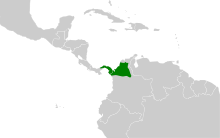
The russet-throated puffbird is a species of near-passerine bird in the family Bucconidae, the puffbirds, nunlets, and nunbirds. It is found in Colombia and Venezuela.

The grey-headed dove (Leptotila plumbeiceps) is a large New World dove. It is found from eastern Mexico to Colombia.

The speckled chachalaca is a species of bird in the family Cracidae, the chachalacas, guans, and curassows. It is found in Bolivia, Brazil, Colombia, Ecuador, and Peru.
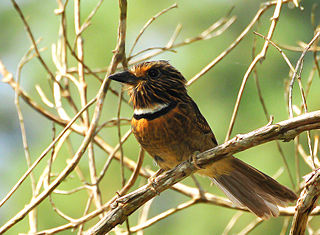
The crescent-chested puffbird is a species of near-passerine bird in the family Bucconidae, the puffbirds, nunlets, and nunbirds. It is endemic to Brazil.

The white-fronted nunbird is a species of near-passerine bird in the family Bucconidae, the puffbirds, nunlets, and nunbirds. It is found Bolivia, Brazil, Colombia, Costa Rica, Ecuador, Honduras, Nicaragua, Panama, Peru, and Venezuela.
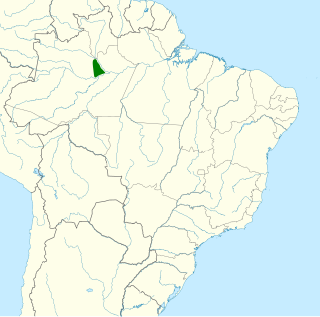
The chestnut-headed nunlet is a species of near-passerine bird in the family Bucconidae, the puffbirds, nunlets, and nunbirds. It is endemic to Brazil.

The brown nunlet is a species of near-passerine bird in the family Bucconidae, the puffbirds, nunlets, and nunbirds. It is found in Colombia, Ecuador, and Peru.
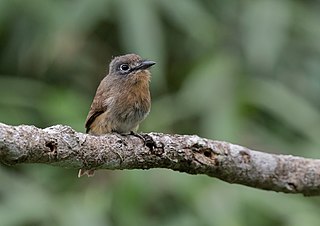
The rusty-breasted nunlet is a species of near-passerine bird in the family Bucconidae, the puffbirds, nunlets, and nunbirds. It is found in Argentina, Brazil, Colombia, Ecuador, Guyana, Paraguay, Peru, Suriname, Venezuela, and possibly French Guiana.

The rufous-capped nunlet is a species of near-passerine bird in the family Bucconidae, the puffbirds, nunlets, and nunbirds. It is found in Bolivia, Brazil, and Peru.

The fulvous-chinned nunlet is a species of near-passerine bird in the family Bucconidae, the puffbirds, nunlets, and nunbirds. It is found in Bolivia, Brazil, and Peru.
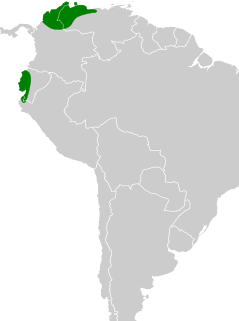
The grey-capped cuckoo is a species of bird in the tribe Phaenicophaeini, subfamily Cuculinae of the cuckoo family Cuculidae. It is found in Colombia, Ecuador, Peru, and Venezuela, as a vagrant on Bonaire and in the Galápagos Islands, and possibly in Panama.

The rufous-vented ground cuckoo is a Vulnerable species of cuckoo in the tribe Neomorphini of subfamily Crotophaginae. It is found in Bolivia, Brazil, Colombia, Costa Rica, Ecuador, Nicaragua, Panama, and Peru.

The red-billed ground cuckoo is a species of cuckoo in the tribe Neomorphini of subfamily Crotophaginae. It is found in Brazil, Colombia, Peru, and possibly Ecuador.

The Azuero dove or brown-backed dove is a species of bird in the family Columbidae. It is endemic to Panama.
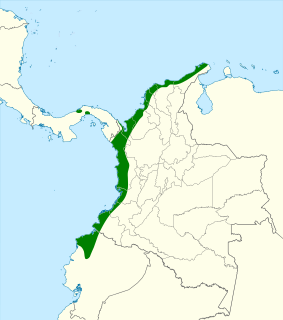
The Colombian crake is a species of bird in the subfamily Rallinae of the rail, crake, and coot family Rallidae. It is found in Colombia, Ecuador, and Panama.

The grey-breasted wood wren is a species of bird in the family Troglodytidae. It is found from Mexico to Bolivia.

The tawny-faced gnatwren or half-collared gnatwren is a species of bird in the family Polioptilidae, the gnatcatchers. It is found in Bolivia, Colombia, Costa Rica, Ecuador, Nicaragua, Panama, and Peru.
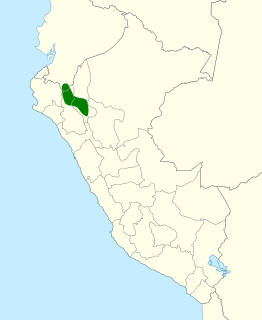
The speckle-breasted wren is a species of bird in the family Troglodytidae. It is found in Colombia, Ecuador, and Peru.

Longuemare's sunangel is a species of hummingbird in the "coquettes", tribe Lesbiini of subfamily Lesbiinae. It is found in Colombia and Venezuela.

The gartered trogon, also known as the northern violaceous trogon, is a near passerine bird in the family Trogonidae, the quetzals and trogons. It is found in Mexico, all of Central America, and Colombia, Ecuador, Peru, and Venezuela.

